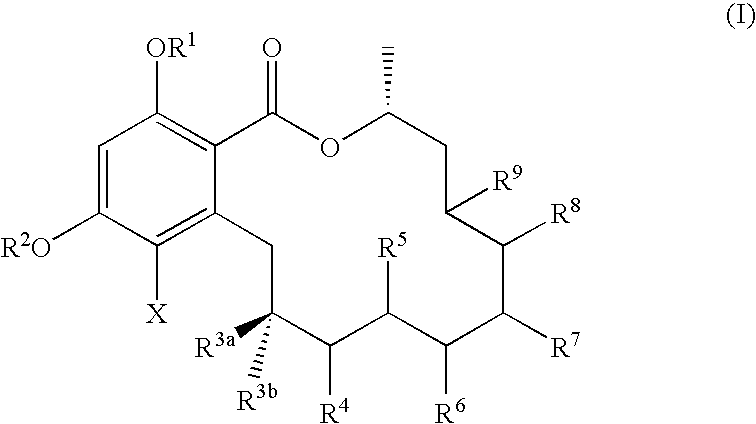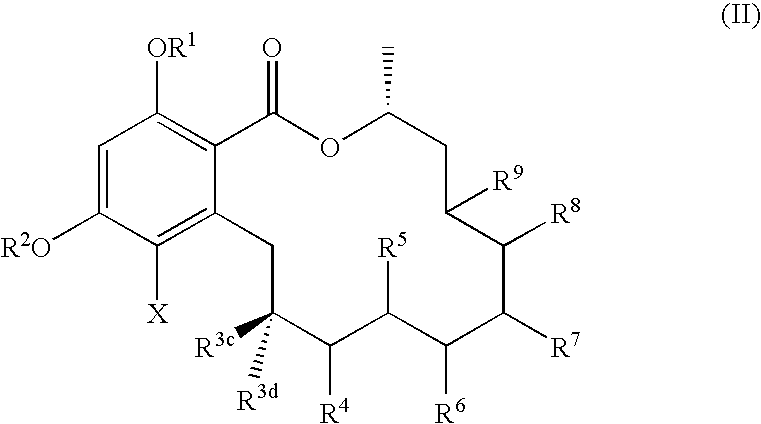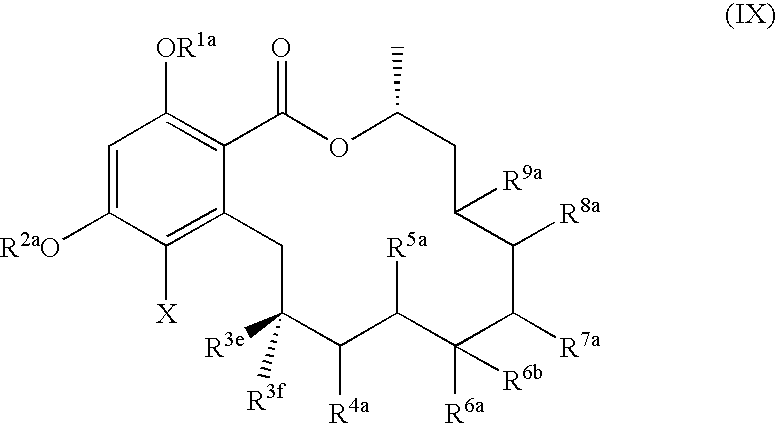Hair growth tonic
- Summary
- Abstract
- Description
- Claims
- Application Information
AI Technical Summary
Benefits of technology
Problems solved by technology
Method used
Image
Examples
example 1
Compounds 3 and 4
[0110] Radicicol (Compound 1: 10.8 g) was dissolved in ethyl acetate (140 ml) and 5% palladium carbon (wet type) (255 mg) was added thereto, followed by hydrogen replacement (1 atm) and stirring at room temperature for 3 hours. After filtering the palladium carbon, the filtrate was distilled off under reduced pressure. The resulting residue was purified by silica gel chromatography and eluted with n-hexane:ethyl acetate (2:1) to give target Compound 4 (3.43 g) was obtained, or eluted with n-hexane:ethyl acetate (3:2) to give target Compound 3 (4.14 g).
example 2
Compounds 7 and 8
[0111] Compound 3 (602.5 mg) was dissolved in methanol (13 ml) and cerium (III) chloride heptahydride (2.14 g) was added thereto, followed by stirring at room temperature for 30 minutes. Next, sodium boron hydride (180 mg) was slowly added to the solution under ice cooling, followed by stirring at room temperature for 5 minutes. After adding saturated disodium hydrogen phosphate (40 ml) to the reaction solution, the mixture was diluted with water (40 ml) and the organic solvent was distilled off under reduced pressure. The residual aqueous layer was extracted with ethyl acetate (300 ml×2). The resulting ethyl acetate layer was dried over anhydrous sodium sulfate and then the ethyl acetate was distilled off under reduced pressure. Then, the residue was crudely purified by silica gel preparative thin layer chromatography (20 cm×20 cm, 1.0 mm in thickness, developed with chloroform:methanol=93:7, eluted with ethyl acetate). The resulting crude purified product was the...
example 3
Compounds 9 and 10
[0112] Compound 4 (26.5 mg) was dissolved in methanol (5 ml) and cerium (M) chloride heptahydride (100 mg) was added thereto, followed by stirring at room temperature for 30 minutes. Ne sodium boron hydride (60 mg) was slowly added to the solution under ice cooling, followed by stirring at room temperature for 30 minutes. After adding saturated disodium hydrogen phosphate (12 ml) to the reaction solution, the mixture was diluted with water (20 ml) and the organic solvent was distilled off under reduced pressure. The residual aqueous layer was extracted with ethyl acetate (30 ml×2). The resulting ethyl acetate layer was dried over anhydrous sodium sulfate and then the ethyl acetate was distilled off under reduced pressure. Then, the residue was purified by silica gel preparative thin layer chromatography (20 cm×20 cm, 0.25 mm in thickness, developed with chloroform:methanol=94:6, eluted with ethyl acetate) to give the target compounds (Compound 9: 5.7 mg, Compound ...
PUM
| Property | Measurement | Unit |
|---|---|---|
| Fraction | aaaaa | aaaaa |
| Fraction | aaaaa | aaaaa |
| Fraction | aaaaa | aaaaa |
Abstract
Description
Claims
Application Information
 Login to View More
Login to View More - R&D
- Intellectual Property
- Life Sciences
- Materials
- Tech Scout
- Unparalleled Data Quality
- Higher Quality Content
- 60% Fewer Hallucinations
Browse by: Latest US Patents, China's latest patents, Technical Efficacy Thesaurus, Application Domain, Technology Topic, Popular Technical Reports.
© 2025 PatSnap. All rights reserved.Legal|Privacy policy|Modern Slavery Act Transparency Statement|Sitemap|About US| Contact US: help@patsnap.com



